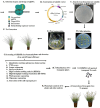Adoption of CRISPR-Cas for crop production: present status and future prospects
- PMID: 38860212
- PMCID: PMC11164064
- DOI: 10.7717/peerj.17402
Adoption of CRISPR-Cas for crop production: present status and future prospects
Abstract
Background: Global food systems in recent years have been impacted by some harsh environmental challenges and excessive anthropogenic activities. The increasing levels of both biotic and abiotic stressors have led to a decline in food production, safety, and quality. This has also contributed to a low crop production rate and difficulty in meeting the requirements of the ever-growing population. Several biotic stresses have developed above natural resistance in crops coupled with alarming contamination rates. In particular, the multiple antibiotic resistance in bacteria and some other plant pathogens has been a hot topic over recent years since the food system is often exposed to contamination at each of the farm-to-fork stages. Therefore, a system that prioritizes the safety, quality, and availability of foods is needed to meet the health and dietary preferences of everyone at every time.
Methods: This review collected scattered information on food systems and proposes methods for plant disease management. Multiple databases were searched for relevant specialized literature in the field. Particular attention was placed on the genetic methods with special interest in the potentials of the Clustered Regularly Interspaced Short Palindromic Repeats (CRISPR) and Cas (CRISPR associated) proteins technology in food systems and security.
Results: The review reveals the approaches that have been developed to salvage the problem of food insecurity in an attempt to achieve sustainable agriculture. On crop plants, some systems tend towards either enhancing the systemic resistance or engineering resistant varieties against known pathogens. The CRISPR-Cas technology has become a popular tool for engineering desired genes in living organisms. This review discusses its impact and why it should be considered in the sustainable management, availability, and quality of food systems. Some important roles of CRISPR-Cas have been established concerning conventional and earlier genome editing methods for simultaneous modification of different agronomic traits in crops.
Conclusion: Despite the controversies over the safety of the CRISPR-Cas system, its importance has been evident in the engineering of disease- and drought-resistant crop varieties, the improvement of crop yield, and enhancement of food quality.
Keywords: CRISPR-Cas9; Environmental stressors; Food security; Genetic engineering; Genome editing.
©2024 Akanmu et al.
Conflict of interest statement
The authors declare there are no competing interests.
Figures

Similar articles
-
Genome editing using CRISPR/Cas9-targeted mutagenesis: An opportunity for yield improvements of crop plants grown under environmental stresses.Plant Physiol Biochem. 2018 Oct;131:31-36. doi: 10.1016/j.plaphy.2018.03.012. Epub 2018 Mar 12. Plant Physiol Biochem. 2018. PMID: 29628199 Review.
-
CRISPR/Cas tool designs for multiplex genome editing and its applications in developing biotic and abiotic stress-resistant crop plants.Mol Biol Rep. 2022 Dec;49(12):11443-11467. doi: 10.1007/s11033-022-07741-2. Epub 2022 Aug 24. Mol Biol Rep. 2022. PMID: 36002653 Review.
-
CRISPR/Cas: A powerful tool for gene function study and crop improvement.J Adv Res. 2020 Oct 21;29:207-221. doi: 10.1016/j.jare.2020.10.003. eCollection 2021 Mar. J Adv Res. 2020. PMID: 33842017 Free PMC article. Review.
-
A Critical Review: Recent Advancements in the Use of CRISPR/Cas9 Technology to Enhance Crops and Alleviate Global Food Crises.Curr Issues Mol Biol. 2021 Nov 11;43(3):1950-1976. doi: 10.3390/cimb43030135. Curr Issues Mol Biol. 2021. PMID: 34889892 Free PMC article. Review.
-
Harnessing CRISPR/Cas9 in engineering biotic stress immunity in crops.Planta. 2025 Jul 15;262(3):54. doi: 10.1007/s00425-025-04769-z. Planta. 2025. PMID: 40663257 Review.
References
-
- Ahmar S, Gill RA, Jung KH, Faheem A, Qasim MU, Mubeen M, Zhou W. Conventional and molecular techniques from simple breeding to speed breeding in crop plants: recent advances and future outlook. International Journal of Molecular Sciences. 2020;21(7):2590. doi: 10.3390/ijms21072590. - DOI - PMC - PubMed
-
- Akanmu AO, Babalola OO, Venturi V, Ayilara MS, Adeleke BS, Amoo AE, Sobowale AA, Fadiji AE, Glick BR. Plant disease management: leveraging on the plant-microbe-soil interface in the biorational use of organic amendments. Frontiers in Plant Science. 2021;12:700507. doi: 10.3389/fpls.2021.700507. - DOI - PMC - PubMed
Publication types
MeSH terms
LinkOut - more resources
Full Text Sources

